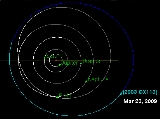
2003 QX113
Encyclopedia
, also written as 2003 QX113, is a detached object that was discovered when it was near aphelion
. With an absolute magnitude
of 4.9, it may qualify as a small dwarf-planet candidate.
It is currently 59 AU from the Sun, and will come to aphelion
around 2058. It last came to perihelion
around 1883. This makes it currently one of the most distant known large bodies (59AU) in the solar system
after Eris
(96.7AU), Sedna
(88AU), 2007 OR10 (86AU), and 2006 QH181
(82AU).
It has been observed 23 times over 6 oppositions and has an orbit quality of 4.

Apsis
An apsis , plural apsides , is the point of greatest or least distance of a body from one of the foci of its elliptical orbit. In modern celestial mechanics this focus is also the center of attraction, which is usually the center of mass of the system...
. With an absolute magnitude
Absolute magnitude
Absolute magnitude is the measure of a celestial object's intrinsic brightness. it is also the apparent magnitude a star would have if it were 32.6 light years away from Earth...
of 4.9, it may qualify as a small dwarf-planet candidate.
It is currently 59 AU from the Sun, and will come to aphelion
Apsis
An apsis , plural apsides , is the point of greatest or least distance of a body from one of the foci of its elliptical orbit. In modern celestial mechanics this focus is also the center of attraction, which is usually the center of mass of the system...
around 2058. It last came to perihelion
Apsis
An apsis , plural apsides , is the point of greatest or least distance of a body from one of the foci of its elliptical orbit. In modern celestial mechanics this focus is also the center of attraction, which is usually the center of mass of the system...
around 1883. This makes it currently one of the most distant known large bodies (59AU) in the solar system
Solar System
The Solar System consists of the Sun and the astronomical objects gravitationally bound in orbit around it, all of which formed from the collapse of a giant molecular cloud approximately 4.6 billion years ago. The vast majority of the system's mass is in the Sun...
after Eris
Eris (dwarf planet)
Eris, formal designation 136199 Eris, is the most massive known dwarf planet in the Solar System and the ninth most massive body known to orbit the Sun directly...
(96.7AU), Sedna
90377 Sedna
90377 Sedna is a trans-Neptunian object discovered in 2003, which was about three times as far from the Sun as Neptune. For most of its orbit it is even further from the Sun, with its aphelion estimated at 960 astronomical units , making it one of the most distant known objects in the Solar System...
(88AU), 2007 OR10 (86AU), and 2006 QH181
2006 QH181
', also written as 2006 QH181, is a trans-Neptunian object. It is very likely a dwarf planet. It is part of the scattered disc. It may be a detached object since a perihelion of 37.6 AU may place it outside of the direct influence of Neptune, or it could have a 5:1 resonance with Neptune...
(82AU).
Assumed size
When was first discovered it was estimated to have an absolute magnitude (H) of 4.9 giving it an assumed size of only 461 km in diameter. As of 2010, is estimated to have a brighter absolute magnitude (H) of 4.7. Assuming it is a trans-Neptunian object with a generic albedo of 0.09, it is about 505 km in diameter.It has been observed 23 times over 6 oppositions and has an orbit quality of 4.

External links
- Orbital simulation from JPL (Java) / Horizons Ephemeris
- What is the most distant body in the Solar System? A historical view (Michael Richmond)

